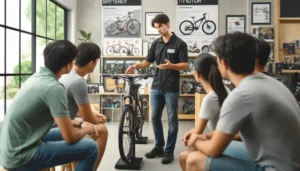A Beginner’s Guide to Buying an E-Bike
E-bikes are surging in popularity as a sustainable, efficient, and convenient way to commute, exercise, and explore. If you’re considering investing in one, it’s essential to know what to look for. This beginner’s guide will help you navigate the options and make an informed choice when buying your first e-bike.
1. Determine Your Riding Needs
Before diving into the technicalities, identify how you intend to use your e-bike. Are you primarily commuting, tackling off-road trails, or looking for leisurely weekend rides? Understanding your primary purpose will help you select the right type:
- Commuter E-Bikes: Ideal for urban travel, with features like fenders, racks, and lights.
- Mountain E-Bikes: Built for off-road adventures with sturdy frames and advanced suspension.
- Folding E-Bikes: Perfect for city living or those who need compact storage.
- Cargo E-Bikes: Designed for carrying heavy loads and even small passengers.
2. Consider Motor and Battery Specifications
The motor is the heart of your e-bike. There are two main types:
- Hub Motors: Placed in the wheel hub, offering a smoother but less powerful ride.
- Mid-Drive Motors: Positioned in the middle of the bike frame, providing better balance and power, especially on hills.
Battery size and type are crucial since they directly affect range. Common battery ranges are between 20 and 100 miles, depending on capacity and the level of assistance used.
3. Choose Your Assistance Level
E-bikes offer different levels of pedal assistance:
- Throttle: Provides instant power with no pedaling needed.
- Pedal Assist: Offers various levels of power to augment your pedaling.
Most e-bikes offer multiple assist modes, allowing you to adjust the level based on your needs.
4. Check the Frame and Weight
Frame material impacts weight and durability. Aluminum is lightweight and rust-resistant, while steel is sturdier but heavier. Carbon fiber is strong and lightweight, ideal for high-end models. Also, test the weight of the bike to ensure it’s manageable.
5. Review Comfort and Safety Features
A comfortable e-bike is crucial for enjoyable riding. Consider the following features:
- Suspension: Front or full suspension helps absorb shocks.
- Brakes: Disc brakes offer reliable stopping power, essential for safety.
- Saddle: A well-padded saddle can make a significant difference on long rides.
- Tires: Thicker tires provide better grip and stability.
6. Set a Budget
E-bikes range from a few hundred to several thousand dollars. Higher prices often mean better components, longer battery life, and advanced features. Decide on your budget beforehand but avoid compromising on essential features.
7. Test Ride and Research
Always test ride an e-bike before purchasing. Make sure it suits your riding style and provides the comfort and power you need. Additionally, read reviews and consult with experts or fellow e-bike enthusiasts for insights.
Final Thoughts
Buying an e-bike is an investment in convenience, health, and eco-friendly commuting. By considering your needs, understanding the technical specifications, and setting a reasonable budget, you can find the perfect e-bike that will offer you years of reliable and enjoyable riding.






